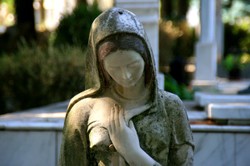The heyday of the shrine was in the late Middle Ages, when there was a growing interest in female saints, but there were dark clouds on the horizon. In 1534 Henry the Eighth dissolved the monasteries and as Winefride's shrine was supervised by Basingwerk Abbey in Cheshire, a county of North West England, it passed into the hands of the state. The Crown passed it onto a courtier, who promptly leased it to a man calledWilliam Holcroft. The deal was that Holcroft would collect the donations made by visitors and pass them on to the Crown. This deal assumed that the shrine would persevere as a holy well with a healing function,. This might seem strange, but not all Protestants were against holy wells as they were against images. The scheme failed. Pilgrims still came but paid no money, instead Catholic sympathizers placed collection boxes for charity there, and the state got nothing.The pilgrims simply kept on coming.
The reign of Elizabeth the First saw some tighter restrictions, especially after the Pope excommunicated Elizabeth and enjoined Catholics to rise against her. That was in 1570. But the shrine was still running in 1579 when Elizabeth ordered that the waters be investigated to see if they were rich in minerals, as many speculated that mineral riches might explain the shrine's healing function. Lack of healing would have got it closed down, but by 1590 the shrine was still operating and able to accept a pilgrimage from Enfield organized by the Jesuit Robert Garner, later wrongly implicated in the gunpowder plot. The pilgrims rested at houses of known Catholics en route and back.
The death of Elizabeth did not end the persecution, and in 1617 the Protestant bishop of Chester suggested that visitors to Holy Well be obliged to swear the oath of allegiance, which no Catholic would take. This may have had a deterrent effect, but not much, as in 1620 Bishop Lewis Bayly set off to Holy Well to personally arrest Catholics visiting the shrine. The visit did not end well, as the local area, Protestants included, rose in defence of the shrine. The bishop was "roughed up" to use modern parlance, and thrown into a ditch. In 1626 John Brigeman, chief justice of Chester, proposed a scheme in which innkeepers were obliged to keep records of who visited the shrine. Again this might have had a small, temporary effect, but in 1629 there was a mass pilgrimage of Catholics numbering about fourteen hundred which went unhindered. In 1637 Bridgeman, who was nothing if not persistent, proposed closing all but two inns in Holy Well, depriving pilgrims of places to stay. He also suggested that a wall be constructed to keep Catholics away from the water. There is some evidence that this proposal was started, but by that time the earliest signs of the impending civil war were showing and the scheme was abandoned. In 1643 parliamentary troops did some damage to the shrine, but not much.
The last significant public involvement was during the brief reign of the Catholic James the Second, who supported the shrine, but then the so called Glorious Revolution restored the Protestant order. However, the days of persecution were coming to an end. There were no more political troubles.






 Pilgrimage. A review23 days ago
Pilgrimage. A review23 days ago
 Leo the Fourteenthon 05/09/2025
Leo the Fourteenthon 05/09/2025
 The Melsonby Hoardon 03/25/2025
The Melsonby Hoardon 03/25/2025




Comments
By accident. We were holidaying in rural South Wales and it was on a local farm.
Thank you!
Perhaps that well no longer exists even as it functioned as an unimportant, "very small well."
Might it become neglected and overgrown? In such case, should it be decommissioned or permitted to merge slowly with the surrounding environment?
(It would be interesting to know how you knew about that well. By accident?)
I am not sure, it was a very small well, probably not an important one.
Thank you!
English Wiktionary lists St. Non's Chapel as having a holy well.
Might that be the holy well that you visited in Pembrokeshire, Wales?
None in Ireland, but I have visited two in Wales, St Winefride's well and one in Pembrokeshire, whose name I have forgotten.
This is related because about holy wells but somewhat unrelated because about Ireland.
Recently, online searches brought up Our ancient landscapes: Holy wells in Ireland, by Am Chomhairle Oidhreachta (The Heritage Council) in 2023.
That publication considers that "However, with over 3,000 holy wells, Ireland has far
more than any other country in the world. Almost every parish in Ireland has its own holy well, and occasionally multiple holy wells."
Have you been to all, none or some of these "blessed wells" (from Gaelic (Tobar Beannaithe)?
Irish monks under Columbanus reached North Italy and other parts of Europe, so they are a possibility, but this is only a possibility. But what is certain is that the presence of your name indicates an Irish influence somewhere, sometime.
Your comments three boxes down consider my name in central and northern Italy as caused by an Irish-monk presence.
When was that presence and why were they where they were in "various parts" of (just continental?) Europe?
Possibly. Archaeology is unlikely to solve this problem, due to absence of material evidence. Only documentary evidence can handle this one.
My Runa Shimi ("language of the people") professor -- the daughter of a Yale University professor and the holder of one PhD in anthropology and another in linguistics -- and her two native speakers accepted the ancient Inca people as native speakers of an unknown language.
Perhaps they archived among themselves their birth, native language even as they assessed very carefully any interactions with the conquered people whose language they assumed.
Might it not be possible that the Tokharians did likewise? Perhaps they nurtured one language for in-group interactions and another -- Gaelic? -- for outsider interactions.